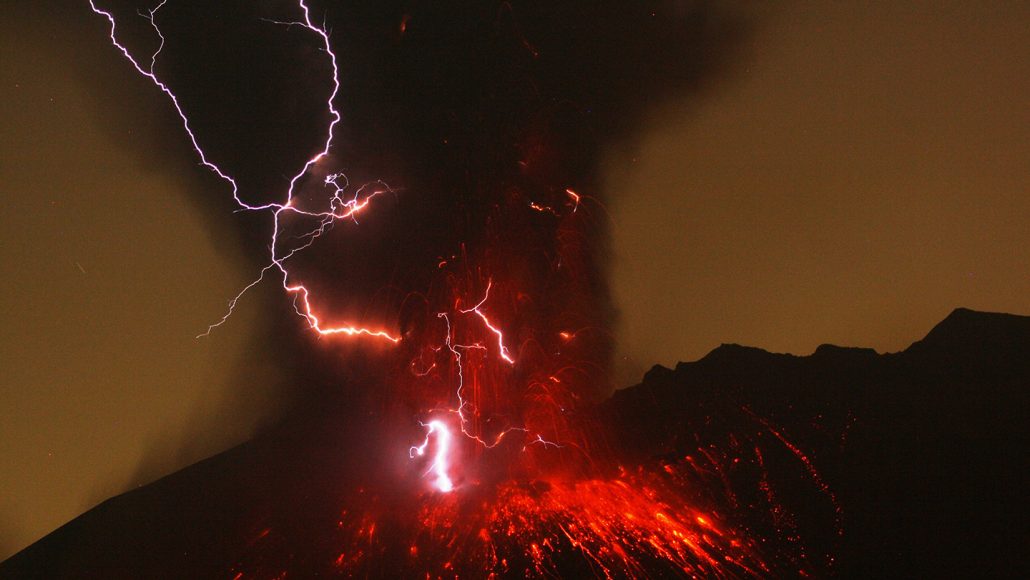Mysterious electrical signals could help warn aviators of impending volcanic ash plumes

Lightning flashes and ash and lava spew as Sakurajima volcano erupts in Japan. A new study distinguishes between lightning and smaller, more mysterious surges of electrical activity produced by the volcano.
MIKE LYVERS/MOMENT/GETTY IMAGES
By Alka Tripathy-Lang
JULY 1, 2021
As one of Japan’s most active volcanoes, Sakurajima often dazzles with spectacular displays of volcanic lightning set against an ash-filled sky. But the volcano can also produce much smaller, invisible bursts of electrical activity that mystify and intrigue scientists.
Now, an analysis of 97 explosions at Sakurajima from June 2015 is helping to show when eruptions produce visible lightning strokes versus when they produce the mysterious, unseen surges of electrical activity, researchers report in the June 16 Geophysical Research Letters.
These invisible bursts, called vent discharges, happen early in eruptions, which could allow scientists to figure out ways to use them to warn of impending explosions.
Researchers know that volcanic lightning can form by silicate charging, which happens both when rocks break apart during an eruption and when rocks and other material flung from the volcano jostle each other in the turbulent plume (SN: 3/3/15). Tiny ash particles rub together, gaining and losing electrons, which creates positive and negative charges that tend to clump together in pockets of like charge. To neutralize this unstable electrical field, lightning zigzags between the charged clusters, says Cassandra Smith, a volcanologist at the Alaska Volcano Observatory in Anchorage.
Experiments have shown that you can’t get lightning without some amount of ash in the system, Smith says. “So if you’re seeing volcanic lightning, you can be pretty confident in saying that the eruption has ash.”
Vent discharges, on the other hand, are relatively newly detected bursts of electrical activity, which produce a continuous, high-frequency signal for seconds — an eternity compared with lightning. These discharges can be measured using specialized equipment.
By focusing on small explosions from Sakurajima, defined as those with plume heights of 3 kilometers or less and with a duration of less than five minutes, Smith and colleagues examined silicate charging, plume dynamics and the relationship between volcanic lightning and vent discharges. As expected, the team found that lightning at Sakurajima occurred in plumes replete with ash. Vent discharges, however, occurred only when ash-rich plumes with volcanic lightning rocketed skyward at velocities greater than about 55 meters per second.
“Once you get to a certain intensity of eruption,” Smith says, “you’re going to see these vent discharges.”
Monitoring these discharges could be especially helpful for quickly spotting eruptions that have a lot of ash in them. Tracking ash is vital, Smith says, “because that’s what’s dangerous for aviation and local communities” in many instances. Electrical activity, she says, signals an ash-rich plume no matter the weather or time of day, and vent discharges provide a measure of an eruption’s intensity, which could help observatories model where a plume might go.
Tracking lightning and vent discharges could cover gaps left by other ways of monitoring volcanoes, says Chris Schultz, a research meteorologist at NASA’s Marshall Space Flight Center in Huntsville, Ala. Seismologists track underground movements of magma to look for signs of an impending eruption, for example. Infrasound is used to indicate when an explosion has occurred, but the technique doesn’t differentiate between ash versus gas in eruptions. And satellites collect data on eruptions, though in many cases that’s dependent on good weather at the right time.
The lightning and vent discharges, Schultz says, may also eventually provide early warnings, especially prior to larger ash-rich eruptions.
No comments:
Post a Comment